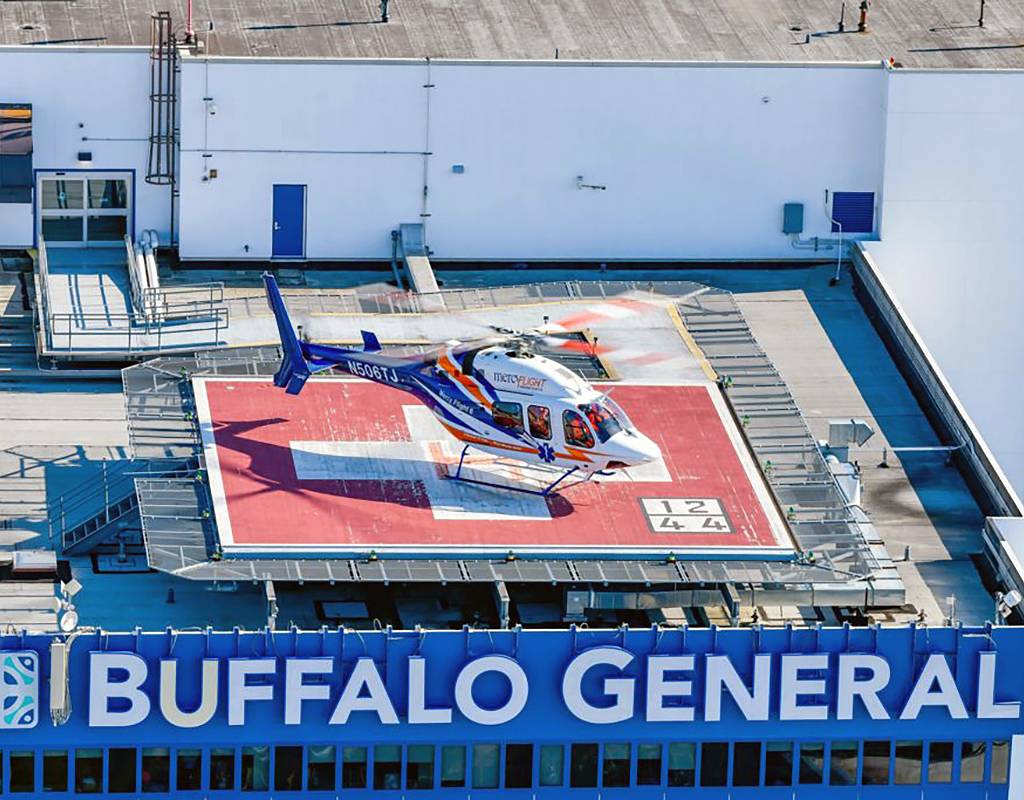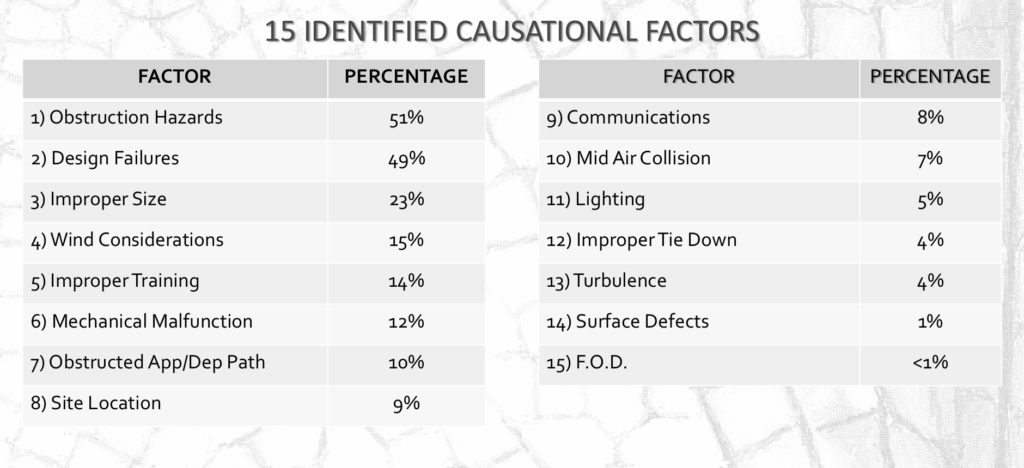
While many helicopter accidents at heliports between 1965 and 2013 in the U.S. were ultimately attributed to pilot error, the real culprits appear to be a lack of adherence to accepted design standards and inadequate education.
These were the key findings revealed in a white paper presented on May 11 at Vertical Flight Society’s Forum 77. Titled “A Retrospective & Historical Analysis of Vertical Lift Infrastructure Accidents for the Purpose of Operational Risk Identification and Accident Prevention,” the peer-reviewed paper set out to identify predictable and preventable elements at designated helicopter landing and takeoff facilities that contributed to accidents, identify risk mitigation strategies, and provide insight to help drive future best practices for advanced air mobility (AAM) infrastructure design and operation.
The paper was researched, written, and presented by four U.S. Helicopter Safety Team (USHST) members: Rex Alexander, president and executive director of Five-Alpha; Raymond Syms, owner and managing member of HeliExperts International; Cliff Johnson, research engineer at the Federal Aviation Administration (FAA) William J. Hughes Technical Center; and John Roberts, senior air safety investigator at the U.S. Department of Transportation’s Transportation Safety Institute (TSI).
“This work started about 15 years ago as Ray [Syms] began looking at trends in accident causes at heliports, helipads, and other designated helicopter landing sites,” explained Alexander. “I joined the research in 2009. We soon started to notice the root causes were much more complicated than indicated in the NTSB [National Transportation Safety Board] reports. We added other subject matter experts from the [USHST] team to the discussion to explore further.”
Johnson brought his FAA team’s statistical analysis skills to the table to help review the accident information. Roberts runs the heliport evaluation and helicopter accident investigation courses at the TSI. Roberts’ knowledge of what investigators were looking for in accidents and how they collect and categorize findings was instrumental in helping uncover a missing piece in accident investigation — the fact that the incident report checklist used by investigators, FAA Form 8020-23, includes little to no data fields for helicopter infrastructure.
As the team reviewed accidents at heliports, helipads, and other designated helicopter landing sites during the 48-year target period, they identified 185 accidents that met their study criteria — civil accidents in the U.S. and its territories that took place at designated helicopter landing and takeoff infrastructure (heliport, helistop, helideck, or airport). They broke the accidents down, accounting for time of day, pilot experience, phase of flight, operations (Part 91, 135, 133, etc.), weather, and site location (ground, rooftop, offshore, etc.).
In the end, the team identified 15 causational factors to the accidents. In some cases, more than one factor was found to be involved. The three most common factors were obstruction hazards, design failures, and improper size while the least common were turbulence, surface defects, and foreign object debris (FOD).

It was when they looked closer at those most common causes that the team began to see a disturbing pattern.
“One of the biggest challenges was finding the information on accidents involving infrastructure issues,” Alexander said. “We went through every single helicopter accident that took place during that time period before we were able identify if they took place at a heliport, helideck, or other designated landing site. In most cases infrastructure was never looked at or identified.”
What’s more, after determining accidents took place at designated helicopter infrastructure, the team noticed accidents were more prevalent at improperly designed sites such as those that did not provide clear unobstructed approach/departure paths or those that allowed hazards to exist in close proximity to the landing and takeoff area. More often than not, the final determination of these accidents was listed as pilot error.
“When we looked further, focusing on the regulations around pilot training, course syllabuses, and books for pilots, it became apparent pilots are not educated about heliport infrastructure,” Alexander said of the accidents and their final determinations. “How can we expect pilots will make educated decisions about the proper design and use of a heliport when we don’t teach them how to determine if the site is appropriate or safe? Yet we blame the pilot for the accident.”
The white paper noted in its conclusions that “the FAA Helicopter Flying Handbook, FAA-H-8083-21B (2109), does not use nor define even the most basic terms such as Heliport, TLOF, or FATO. The FAA Helicopter Instructor’s Handbook FAA-H-8083-4 (2012) does use the term Heliport three times but only for the purposes of discussing lighting precautions for night operations. The Helicopter Instructors Handbook also does not have the terms TLOF or FATO and neither of these handbooks outline what the information box on a heliport is and how to interpret the limitations it identifies. This lack of information was also found to be prevalent in the Aeronautical Information Manual (AIM) as well.”
“By far, the biggest finding of this work and the paper was the lack of education for pilots,” Alexander said. “I was surprised we don’t educate pilots better on what safe infrastructure is supposed to look like. In 2012, the FAA introduced a new heliport safety marking known as the touchdown positioning circle. To date there has been no pilot education that talks to it. While there is a lot of information in the FAA heliport design advisory circular, it’s been my experience as a pilot, instructor, and operations manager that most pilots do not go out of their way to find and read advisory circulars.”
In addition to the lack of education for pilots to determine the adequacy and safety of a designated helicopter landing/takeoff site, the paper also found a significant lack of designated helicopter landing sites following the FAA heliport design advisory circular (AC 150/5390 Heliport Design). The AC outlines recommended standards for all aspects of a heliport, from the design helicopter (the largest helicopter the heliport is designed to serve), lighting, markings, and obstruction identification to the approach/departure airspace. There is no federal requirement to abide by the AC standards for private-use facilities, which account for 99 percent of all U.S. and all but six of the nation’s 2,500-plus hospital heliports. Some states and municipalities do tie it into their zoning and land use laws, but not all. Because of this, the determination if a heliport is actually safe falls on the user.
Alexander and his team continue to press for more education in the form of edits to pilot and instructor handbooks and the FAA AIM, as well as changes in accident investigation to better identify substandard and unsafe heliports. The TSI offers a course on heliport evaluation, as well as basic and advanced helicopter accident investigation courses where infrastructure accident techniques are taught, helping train investigators how to determine if infrastructure played a role in an accident.
Alexander and the white paper team hope their findings will provide valuable risk mitigation strategies to inform future vertiport standards for the developing eVTOL and AAM market.
“We are putting these lessons learned into vertiport development,” said Alexander, who works with the Vertical Flight Society, ASTM International, the FAA, and the NFPA in developing future vertiport standards. “If we develop standards based on what we have learned in the helicopter industry, our risk potential decreases exponentially. The major focuses should be appropriate and protected airspace, accurate geometry based on the dimensions of the design aircraft, aircraft performance capabilities, and improved education for pilots, inspectors, municipalities, and states on what constitutes regulatory compliant and safe infrastructure.”
Alexander added: “The underlying reason many of these accidents occurred was due to a lack of oversight. As we develop vertiports for advanced air mobility, we must develop a system that accounts for this shortcoming. Perhaps something that is more in line with FAA Part 121 requirements for following Part 139 airport certification standards. Providing these types of safety assurances is going to be a big part of fostering public acceptance of eVTOL and AAM in the future.”



